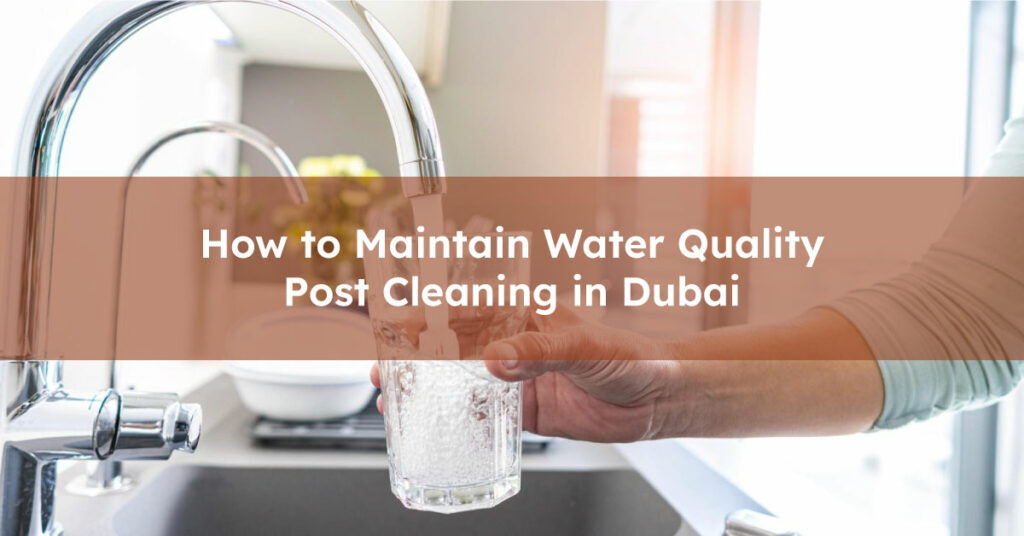After cleaning your water tank in Dubai, it is crucial to take the necessary steps to maintain water quality. By implementing a regular maintenance routine, you can ensure that the water in your tank remains pure and safe for ongoing use.

In this guide, we will provide valuable tips on how to maintain water quality post cleaning in Dubai.
Table of Contents
Key Takeaways
- Regularly monitor the quality of your water through routine tests
- Implement a water treatment plan tailored to your specific water supply
- Secure tank openings to prevent contamination
- Conduct routine inspections to detect leaks and damage
- Consider professional water tank cleaning services for enhanced water quality maintenance
Regular Monitoring of Water Quality
By conducting routine water tests, you can identify any potential issues such as bacterial contamination or chemical imbalance.
It is recommended to test the water at least once a month to detect any changes early on. Various water testing kits and services are available in Dubai to help you monitor the quality of your water reliably.
“Regular monitoring of water quality is crucial for ensuring the safety and purity of your water supply. By conducting regular water tests, you can promptly identify any problems and take appropriate actions to maintain water quality.
| Water Quality Parameter | Standard Range | Recommended Frequency |
|---|---|---|
| pH | 6.5-8.5 | Monthly |
| Total Dissolved Solids (TDS) | Less than 500 ppm | Monthly |
| Chlorine | 0.2-4.0 ppm | Monthly |
| Bacterial Contamination | No presence | Semi-annually |
By adhering to the recommended frequency of testing, you can detect any deviations from the standard range and take appropriate steps to address them.
Remember, it’s not only the cleanliness of your water tank that matters, but also the ongoing monitoring and maintenance of water quality that ensures a continuous supply of clean and safe water for your household.
If you require professional assistance with water tank cleaning in Dubai our team of experienced technicians are always ready to help you. Feel free to contact us on WhatsApp any time.
Implementing a Water Treatment Plan
Implementing a water treatment plan is crucial to maintain water quality after cleaning.
Depending on the specific needs of your water supply, you may need to disinfect, filter, or purify the water to remove impurities effectively.
There are various water treatment methods available, including:
- Chlorination: This method involves adding chlorine or chlorine-based chemicals to the water to kill bacteria and viruses.
- UV Disinfection: UV light is used to destroy microorganisms in the water, effectively disinfecting it without altering its taste or odor.
- Reverse Osmosis: This process uses a semi-permeable membrane to remove contaminants from the water, including dissolved minerals and particles.
- Activated Carbon Filtration: Water passes through activated carbon filters that adsorb and trap impurities, including chemicals, pesticides, and odors.
When choosing the right treatment method for your water quality requirements, it is essential to consider factors such as the level of contamination, the desired level of water purity, and any specific concerns related to taste, odor, or health.
Consulting with a professional water treatment specialist can help you determine the most suitable method for your needs.
| Treatment Method | Advantages | Disadvantages |
|---|---|---|
| Chlorination | – Effectively kills bacteria and viruses – Relatively low cost | – May result in taste and odor changes – Can produce disinfection by-products |
| UV Disinfection | – Chemical-free disinfection – No taste or odor changes – Simple operation | – Requires electricity to operate – Does not remove chemical contaminants |
| Reverse Osmosis | – Removes dissolved solids and contaminants – Improves taste and odor – Highly effective | – Higher initial cost – Requires regular maintenance – Wastes some water during the process |
| Activated Carbon Filtration | – Removes chemicals, pesticides, and odors – Simple operation – Enhances taste and odor | – Requires regular replacement of carbon filters – Does not remove dissolved solids |
By implementing the appropriate water treatment method or a combination of methods, you can ensure that your water remains clean, safe, and suitable for your intended use.
Remember to regularly monitor and maintain your water treatment system to ensure its effectiveness in preserving water quality.
For a detailed guide on water tank cleaning in Dubai, please refer to our comprehensive water tank cleaning guide.
Secure Tank Openings to Block Contaminants
Secure tank openings are essential to prevent contamination and maintain the purity of the water supply. Here’s why securing tank openings should be a priority:
- Prevent Contamination: By ensuring that tank openings are properly sealed, you can effectively block contaminants such as dirt, insects, or rodents from entering the water supply. This helps to maintain the water quality and prevents potential health hazards.
- Tank Lid Maintenance: Regularly inspecting and maintaining the tank lid is crucial to ensure a tight seal. This includes checking for any cracks, rust, or damage that may compromise the integrity of the lid. Repair or replace the lid as necessary to maintain a secure barrier.
- Tank Vent Protection: Tank vents are often susceptible to blockages by debris, insects, or small animals. Installing secure vent covers or screens can prevent these obstructions and maintain proper airflow without compromising water quality.
By proactively securing tank openings, you can safeguard the purity of your water supply and prevent potential contamination.
Regular inspections and maintenance should be part of your ongoing water quality maintenance routine.
Routine Inspections for Leaks and Damage
Regular inspections play a crucial role in maintaining the quality of your water supply after cleaning.
By conducting routine checks, you can detect any potential issues before they become major problems. Here’s why routine inspections are essential:
- Early Detection of Leaks: Inspecting your water tank regularly allows you to identify and address any leaks promptly. Leaks can lead to water wastage, increased water bills, and potential contamination.
- Prevention of Water Damage: Routine inspections help prevent water damage to your property. By identifying and repairing any structural issues or leaks, you can avoid costly repairs and minimize the risk of mold or mildew growth.
- Preservation of Water Quality: Leaks or damage to your water tank can compromise the quality of your water supply. Regular inspections ensure that the water remains clean, free from contaminants, and safe for use.
By incorporating routine inspections into your water tank maintenance routine, you can proactively address any potential problems and ensure the longevity of your water tank’s performance.
| Signs to Watch Out For | Action to Take |
|---|---|
| Corrosion or rust | Replace corroded or rusted parts and consider applying protective coatings. |
| Cracks or fractures in the tank structure | Repair cracks using appropriate sealants or consult a professional for further assistance. |
| Water stains or puddles around the tank | Investigate the source of the water and repair any leaks immediately. |
| Unusual odors or discoloration in the water | Test and treat the water as necessary to maintain its quality. |
Remember, proactive maintenance and regular inspections are vital for ensuring the ongoing quality and reliability of your water supply.
Conclusion
To maintain water quality, it is crucial to monitor the condition of your water regularly. This can be done by conducting routine water tests to detect any potential issues such as bacterial contamination or chemical imbalance.
By testing the water at least once a month, you can identify any changes early on and take appropriate actions to maintain the cleanliness of your water supply.
FAQ
How often should I test the water quality in my tank after it’s been cleaned?
Regular water quality testing is crucial to ensure safety. In Dubai, it’s recommended to test your water at least every six months after a professional cleaning, or more frequently if you notice changes in taste, odor, or color.
What steps can I take to prevent contamination between cleanings?
To prevent contamination, ensure your tank is properly sealed and covered to block debris, insects, and animals. Additionally, inspect your tank regularly for leaks or damages and address them promptly to maintain a clean water supply.
Can installing a water filtration system improve water quality post-cleaning?
Yes, installing a water filtration system can significantly improve your water quality by removing sediments, chemicals, and pathogens from the water as it enters your tank or before it reaches your tap, providing an additional layer of protection.
How do I maintain the cleanliness of the water tank’s surroundings?
Keep the area around your water tank clean and free from waste or vegetation that could harbor pests or lead to contamination. Ensure that drainage is directed away from the tank to prevent water pooling and potential seepage.
What should I do if I notice a decrease in water quality after cleaning?
If you notice a decrease in water quality, such as changes in taste, odor, or color, contact a professional water testing service to assess your water. They can identify the issue and recommend specific actions, which may include additional cleaning or adjusting your water treatment process.




